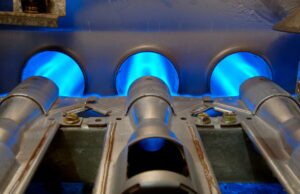Gas-powered furnaces seem to be among the top preferred heaters on the market today. Do you have one? If so, you have one of the most powerful and effective heating systems there is! But how old is it? If it’s 10-15 years old, you might have noticed it experiencing repair and inefficiency issues more frequently. And there’s one particular repair need you should really care about—a cracked heat exchanger!
Read on as we uncover what a heat exchanger is, how it operates, and why you should care if you have a damaged component.
First, What’s a Heat Exchanger?
This is a fair question! The heat exchanger is essentially the component that makes it possible for your gas furnace to actually provide heat. What happens is that combustion gasses fill the heat exchangers, which are metal, clam-shell shaped chambers, and the air from the blower inside your furnace goes over the exchanger, picking up the heat along the way.
Then, the heated air gets distributed into your home through your ductwork and air vents. This process allows your furnace to apply heat from combustion gas to your indoor air, without that combustion gas actually making contact with your indoor air.
How Does One Get Damaged?
Throughout the years, your furnace undergoes a lot of strain and natural wear and tear. Each time the heat exchangers heat up, the metal expands. Then when it cools, it contracts back down. This causes the metal to weaken and it can begin eroding.
The reason you should be especially concerned if your furnace is 10-15 years old is because damaged heat exchangers are much more common in aging furnaces. It’s an important problem to be aware of (and prevent) no matter how old your furnace is, though. Things like manufacturer defects or excessive wear and tear—albeit rare—can have an impact on this component as well.
Why Is a Cracked Heat Exchanger Bad News?
When we talk about cracked or damaged heat exchangers, we’re not talking about damage that is easily visible to you. In fact, not only are heat exchangers not accessible to the average homeowner (it takes specialized skill and professional grade tools) but even if you reached the heat exchanger, the crack can be so small it would be invisible to the naked eye.
As noted above, the metal heat exchangers expand and contract with heat. When contracted, you won’t be able to see any cracks. But if even the smallest crack is present, combustion gas—namely, carbon monoxide (CO)—can leak out and into your living space. CO poisoning is a very real risk and is hazardous, leading to hundreds of fatalities throughout the U.S. each year.
Be sure to schedule annual heating maintenance so we can keep an eye on how your system is doing. We even provide video inspection of heat exchangers—something our competitors don’t offer. Installing CO detectors in your home is also an important step, as is calling a pro any time your heater seems “off.”
When you need a fast response for your Lubbock, TX heating service needs, you need to give our team a call! Contact JD’s Prompt Plumbing, Heating & Air Conditioning today.


